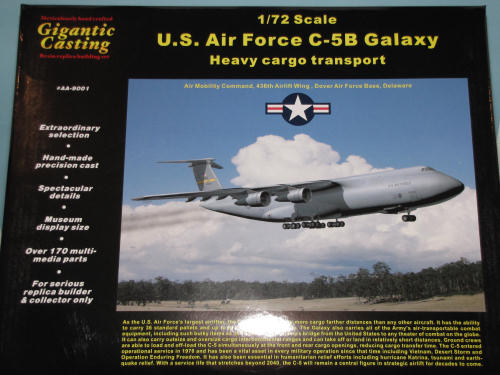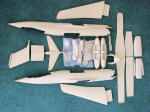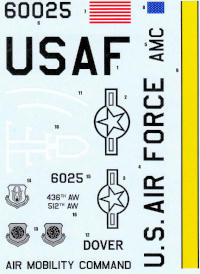
Anigrand Craftworks 1/72 C-5A/B
Galaxy
| KIT #: | AA-9001 |
| PRICE: | $385.00 |
| DECALS: | One option |
| REVIEWER: | Chris Ishmael |
| NOTES: | Full resin kit |

| HISTORY |
| THE KIT |
 Almost
all of the major exterior parts are split in halves, mostly top & bottom. The
fuselage is in 4 pieces , split left to right, forward & aft. The nose visor,
Almost
all of the major exterior parts are split in halves, mostly top & bottom. The
fuselage is in 4 pieces , split left to right, forward & aft. The nose visor,
The interior of the fuselage has molded in
ribs, but the kit does not come with any type of insulation blankets normally
found on the aircraft. The cargo
bay floor & ceiling are both split into forward & aft sections.
The cargo floor does have raised ridges, which when painted, should
replicate the typical pattern of non-skid & bare metal.
The ceiling has a waffle like pattern, which approximates the real deal.
The ceiling also is the floor of the upper deck. There is no real detail
to speak of on the upper deck, since it will all be hidden, unless the modeler
chooses to remove the molded in upper deck doors, much like what is seen at the
typical hot summer airshows, where the doors are open for ventilation.
The cockpit consists of seats & no instrument panel, but again, its
almost impossible to see anything through the clear resin windshield.
Each of the TF-39 engines consist of the left &
right halves, with the pylon molded as part of the inboard half, the visible
first stage fan blades, and the exhaust cone. The completed engine assys do have
a specific location on the wing, as the pylon/wing mating surface is different
for each engine because of the slanting curvature of the wing bottom.
The wings have large mounting tabs & two large
holes for the separate center section to mount to.
The center section serves as a interlock for both wings, & also forms the
exterior fuselage for the wing section.
There are 6 individual flap actuator fairings for each wing,
& are of different sizes depending on their location on the wing.
A clear resin position light is provided for each wingtip.
The landing gear consists of 25 identical
wheels, 2 wheels with an open center for the inboard nose wheels, & 2 wheels
that seen to have been through in as spares, because they donít match any of the
other wheels in term of center hole pattern.
The shock strut portion of the main gear is made from turned aluminum,
the 8 retraction jackscrews are brass, & the torque tube the wheels mount to are

The instructions have several black &white
photographs showing the location of the parts once that assembly is complete.
All the parts are labeled on the instructions, but none are labeled on
the parts themselves, so some comparison dry fitting will be required.
The decals consist of two identical sheets for
an example from Dover AFB. Each
sheet provides markings for one side of the model. The sheet does have the white
aerial refueling markings plus the two white stripes that are typically found on
top of the nose visor.
Yes folks, this is a big, big model.
The fuselage will stretch to about 40 inches from nose to tail, & the
wings will only need 2 inches less space at 38 inches, tip to tip.
In my dry fitting so far, it seems it will be a tail sitter, since the
balance point, so far, is behind the aft most gear. Itís not for the beginner,
as the instructions are very simplified, & knowledge of working with resin is a
must. The potential is there for
loading the cargo deck with typical load outs.
A quick search on the web did turn up 1/72 HMMVS kits, and another search
turned up images of aircraft being loaded into the cargo deck that are available
as a 1/72nd kit.
| CONCLUSIONS |
If you have the space, time, desire, & most of
all, disposable income to get this kit, go for it.
You might never see this aircraft as typical injection molded kit in this
scale.
Review courtesy of me & my wallet.
If you would like your product reviewed fairly and fairly quickly, please contact the editor or see other details in the Note to Contributors.